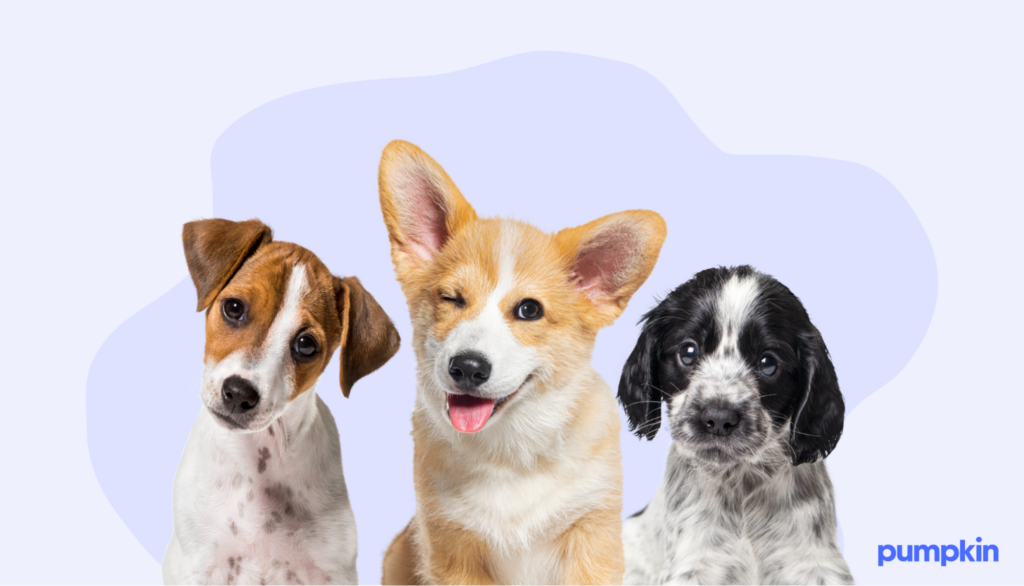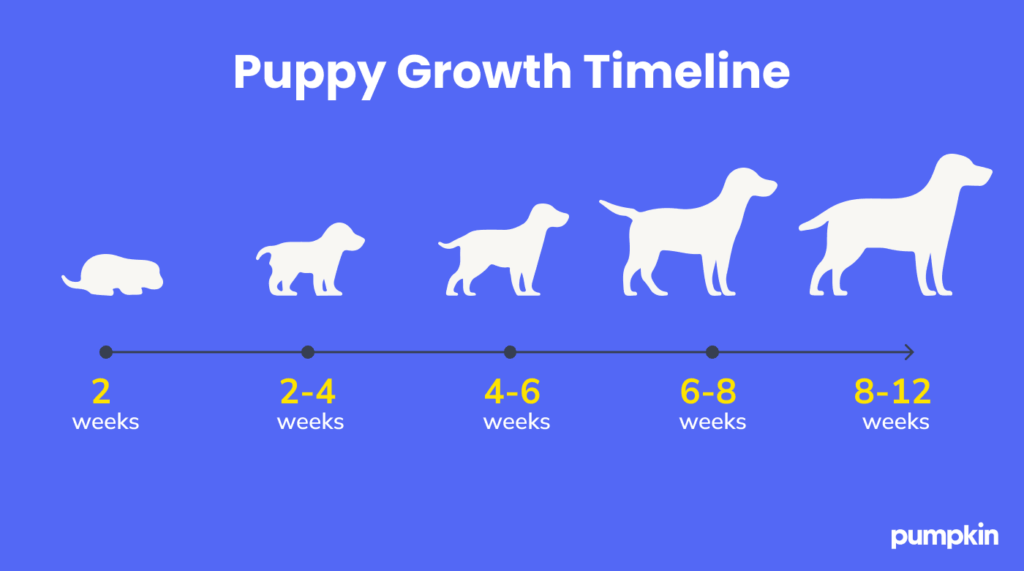Key points
- Puppies usually open their eyes by day 10 and show their true eye color by week 10.
- While their vision starts out blurry, puppies can see blue and yellow and have great night vision.
- Keep your puppy’s eyes healthy with regular cleaning and a balanced diet. Consult your vet if you notice swelling or odd discharge.
If your dog has recently welcomed a litter of adorable puppies, you’re likely going through a whirlwind of emotions and responsibilities. Amidst the feeding and cleaning, you’re probably wondering when those tiny eyes will open. So, when exactly does this magical moment happen?
Understanding the timeline of a puppy’s eye development can help you give them the best start in life. Read on to learn more about when puppies open their eyes, what to expect, and how to care for those precious peepers.
When do puppies open their eyes?
Puppies start to open their eyes around the 10-day mark. However, don’t expect to see their true eye colors just yet. Initially, most puppies’ eyes are in blue-gray hues, but their genuine color will shine through at about 10 weeks of life.
Unless you’re a breeder or raising newborn puppies, you shouldn’t have a puppy before their eyes are open. These early weeks are important for their development and bonding. So, they should stay with their mother and littermates.
A lot happens in the first eight weeks before puppies can head to their forever homes. Not only are their eyes changing shades, but their personalities start to shine, too. They become more playful and curious and begin forming a bond with their littermates as they explore their surroundings.
Why don’t puppies open their eyes right after birth?
Puppies are born with their eyes sealed shut, not because they’re just too sleepy, but because their visual system still needs time to fully develop.
Their closed eyelids act like shields, protecting their eyes from bright light and potential bumps during the most vulnerable stage of their life. While they wait for their eyes to open, they rely on their senses of smell and touch to navigate the world and find their mother’s milk.
What do newborn puppies see when they open their eyes?
When newborn puppies first open their eyes, their world isn’t a vivid landscape like ours — it’s more like a fuzzy, slightly blurry snapshot.
This blurry vision isn’t a defect. It’s just a part of their development process because the retina, optic nerve, and specific brain regions are still maturing. Their vision improves over time, reaching full vision at about 8 weeks old. At around 16 weeks old, they’ll be able to discern distance (and spot that squirrel in the backyard with no problem).

One common myth is that puppies (and dogs) are completely colorblind. Let’s set the record straight. While they may not see the world in the same color as you, puppies can see certain colors.
They have dichromatic vision, which means they can tell between blues and yellows, but reds and greens appear more grayish. Dogs also have a night vision advantage over humans. With more rods in their eyes, they’re amazing at seeing in low light.
Dogs’ eyes are wired for movement, not fine details, even as adults. This is why it’s baffling when your pup misses the treat right in front of them, yet zaps towards a flying toy. Those ancient hunter genes make them super alert to anything that moves.
What happens if your puppy’s eyes remain closed?
While most puppies open their eyes at around 10 days, some stubborn eyelids can stay shut for more than two weeks. There’s no need to panic yet — sometimes it’s just normal delays.
However, if your puppy’s eyes remain closed for over three weeks, make a visit to the vet. There may be potential health concerns, so watch for these signs:
- Swelling or redness around the eyes
- Pus or discharge from the eyes
- Your puppy pawing at their eyes
Early intervention is important for successful treatment. If you want to make sure your puppy receives the best care possible as they grow up, learn more about Pumpkin puppy insurance plans.
A timeline of puppy eye development
Your puppy’s eyes will continue to develop for 8-12 weeks. These are the stages they go through in those early weeks:

2 weeks
The magical moment has come— your puppy’s eyes have opened! While their vision is still developing and the world may seem a bit fuzzy, they’ll begin exploring their surroundings by smell and touch. It’s important to avoid harsh, bright lights and loud noises that may startle your pup during this stage.
2-4 weeks
Between 2-4 weeks, their vision starts to improve and sharpen. They’ll begin to recognize familiar faces (like yours) and navigate their surroundings with more confidence. Expect some adorable clumsiness as they bump and tumble over their own paws. Keep an eye out for any signs of eye irritation, such as redness, swelling, or discharge.
4-6 weeks
Depth perception kicks in, and your puppy can now judge distances with increasing accuracy. They’ll become more playful and interactive — think serious puppy zoomies.
6-8 weeks
Around this time, your puppy’s vision reaches near-adult levels. They can now see the world with clarity. This improved vision supports their learning, so it’s a great time to start training them. Establish a regular eye-care routine, like gentle cleaning, and monitoring, to keep those eyes sparkling.
8-12 weeks
With their vision fully mature at around the 12-week mark, your puppy is ready to take on the world. You can see their genuine eye colors, which most likely means you’ve fallen under the spell of those puppy eyes. But even with perfect eyesight, routine veterinary care can ensure long-term eye health and catch any potential issues early on.

How to properly care for a puppy’s eyes
Dogs are susceptible to many eye conditions, ranging from conjunctivitis and dry eye to cataracts and glaucoma. So, keep a close eye on any signs of trouble, as early identification and treatment can significantly improve outcomes.
If your pup starts blinking or squinting more than usual, shows redness, has tearing, or exhibits a yellow or green discharge, it’s time for a vet check. Other signs of eye issues include cloudiness, running into things, poor balance, confusion, or a noticeable sensitivity to light.
Some breeds, like short-nosed dogs, Cocker Spaniels, and German Shepherds, are more prone to eye conditions.
Beyond the first blink
As your puppy’s eyes open and their vision develops, a whole new world unfolds for them. It’s a time of bonding and exploration, filled with hilarious attempts at catching their own tail.
Just remember, consistent eye care and regular vet visits are important throughout their lives. After all, those eyes aren’t just windows to their soul — they’re key for spotting dropped treats from across the room.
FAQs
- https://www.akc.org/expert-advice/dog-breeding/breeder-puppy-socialization-early-neurological-stimulation/
- https://wagwalking.com/wellness/how-long-does-it-take-for-puppies-to-open-their-eyes
- https://blackhawkpetcare.com/nz/articles/when-do-puppies-open-their-eyes/.
- https://www.vetinfo.com/dogsee.html
- https://www.akc.org/expert-advice/health/puppy-senses/
- https://ckcusa.com/blog/2023/june/how-dogs-see-the-world-insights-into-canine-vision/
- https://www.petsecure.com.au/pet-care/caring-for-your-dogs-eye-health/
- https://khpet.com/blogs/dogs/newborn-puppy-care-week-by-week




